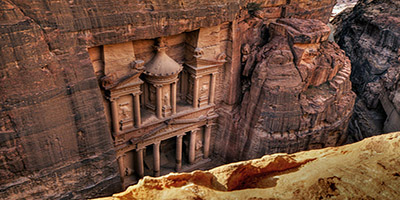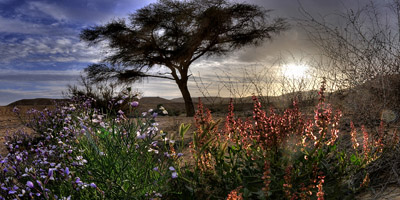12 days tour of Israel, Jordan and Egypt. Visit the Negev, Jordanian and the Sinai deserts.
'The desert is not dying, it is merely waiting with infinite patience.'
Abraham Shaked-1990

Negev, Sinai, Jordan tour: Petra
The New York Times is recommending Desert Eco Tours' desert trips
We received the 'Tripadvisor Award of Excellence' of 2010, 2011, 2012, 2013
Video of camel tour in the sand stone area of Sinai
This trip combines the desert's majestic and diverse landscape, with an intimate encounter with desert societies, past and present. Participants will have the opportunity to become acquainted with the material and spiritual culture of the desert people, spanning a period of 10,000 years. Learning about their unique characteristics, as well as their relations with the peoples of the Near East fertile zones.
Traveling in well-equipped four-wheel drive vehicles and spending nights at desert inns, camping outdoors as well as hotels (indicated below). We provide all logistic facilities, including tents mattresses, sleeping bags, water, food etc. The tour will include several hikes of up to 6 hours (optional).
The specialist guide is archeologist, Dr. Uzi Avner, an expert on desert archeology and culture, proficient in both Hebrew and English. Evening lectures with slide presentations are also offered, according to the participant's interest.
The Trip's Program:
The following itinerary presents a brief description of the areas we'll focus on and visit. Additional natural wonders and ancient sites will be visited en-route from one point of interest to another (Click pictures to enlarge).
Southern Negev:
First night in Eilat, Introductory lecture.
Overnight at Eilat (hotel).
Day 1- Eilat- Har Karkom (SW Negev Highlands).
The Har Karkom area contains the largest concentration of rock art in the entire Negev, with over 45,000 documented rock drawings. It is also rich with archeological sites of various types and periods. Some have suggested that the mountain be identified as the biblical Mount Sinai.
Overnight at Be'er ‘Adah (open-air camping).
Day 2- Nahal Paran-Har Tsuri'az (Southern Negev).
The crossroads of several ancient trade routes with a group of water wells and surrounded by the remains of many ancient camps. Most intriguing are clusters of cult sites, with open-air sanctuaries, standing stone shrines and well-built tombs, dated to the 6th-3rd millennia B.C. Of special interest are the remains of agricultural fields with an irrigation system based on floodwater, dated to the 5th-4th millennia B.C., the oldest known to date in the desert. North Arabian rock inscriptions (ca. 2000 years old) can be seen in several places.
Overnight at Ma'aleh Shaharut (desert inn).

The Monastery of St. Catherine: Sinai
Day 3- ‘Uvda Valley (Southern Negev).
Despite the hyper arid conditions, ‘Uvda valley contains the largest concentration of archeological sites, of the last 10,000 years, in the Negev and Sinai. It includes three Early Neolithic habitation sites (8th-7th millennia B.C.), over 150 habitations of the Late Neolithic, Chalcolithic and early Bronze periods (6th-3rd millennia B.C.), 40 habitation tent camps and a public building of the biblical period (13-10 centuries B.C.), over 100 Nabatean habitation tent camps and a public building (2nd century B.C. to 6th century A.D.) and the remains of Bedouin agriculture of the last five centuries. There are many agricultural installations, vest cultivated fields, and unique cult and burial sites.
Overnight at Ma'aleh Shaharut (desert inn).
Day 4- Yotvata Oasis and Timna Valley (Southern ‘Arava).
The Yotvata oasis settlement from the 5th millennium B.C. to present, including Chalcolithic copper industry, Early Bronze habitation sites and burials, a large irrigation systems and cultivated fields of the Nabatean, Roman and Byzantine periods (2nd century B.C. to 6th century A.D.), a larger and more sophisticated irrigation system of the Early Islamic period (7th-10 centuries A.D), based on underground water tunnels (Qanat). The oasis also served as an important crossroad, and three different fortresses were built here. One in the Iron age (13th-8th centuries B.C.), the second is Late Roman (3rd-4th A.D.) and the third is Early Islamic. Also intriguing are the remains of a large Nabatean temple.
Timna Valley was a large center for ancient copper mining and smelting. Copper production began here as early as the 5th millennium B.C., continuing and expanding in the following periods. During our visit in the valley we will follow the technological and historical development of copper mining and smelting through 6000 years. Cult sites of various periods also served as an integral part of the industrial plant; most notable is the excavated sanctuary (13th-10th centuries B.C.).
Overnight at Be'er Ora (open-air camping)
Day 5- Eilat Region (Near the Gulf of ‘Aqaba).
Several different sites are visited in this day: 1. Be'er Ora- a cluster of ancient sites surrounding a water source, among them- an Early Islamic village and a copper smelting camp, with small shrines and an open-air mosque. 2. The Evrona Farm, an Early Islamic agricultural farm based on Qanat system, with underground water tunnels. 3. Nahal ‘ Amram, another copper mining center, rock carvings and other ancient remains. 4. Wadi Tawahin, an Early Islamic site of gold production. 5. A “desert kite”, a large animal trap at Har Shahmon (4th and 2nd millennia B.C). 6. A unique Late Neolithic burial ground on the western fringe of Eilat (6th-5th millennia B.C.), with additional cult installations and open-air sanctuaries. 7. “ Darb al-Hajj, the remains of the old Muslim pilgrimage road from Cairo to Mecca.
Border passage to Jordan, overnight at Wadi Ram (desert inn)

Spring in the Southern Negev: Eilat Mts.
Southern Jordan:
Day 6- Wadi Rum, Basta (Southern Jordan).
Wadi Rum is an area of spectacular sandstone formations and an ancient crossroad rich with rock drawings and inscriptions in several ancient languages. There are Neolithic and Chalcolithic habitation (7th and 4th millennia B.C.), open-air sanctuaries and other types of cult sites. Also impressive are the remains of a Nabatean temple and a shrine (1st century B.C. to 2nd century A.D.).
Basta is a present-day village built on top of a Neolithic village (7th-6th millennia B.C.) where excavations exposed two-story buildings, surprisingly similar to modern Architecture. Ample artifacts illuminate the village's life 9000-7000 years ago.
Overnight- Taibet Zaman (hotel)
Day 7- Petra, The famous Nabatean capital (2nd century B.C. to 2nd century A.D.), and later the Roman capital of Provincia Arabia. Monumental tombs, temples and other public buildings are surrounded by magnificent red sandstone cliffs.
Back to Eilat on a scenic road, crossing the Jordanian and the Egyptian borders, Overnight on the Red Sea Coast (Sinai, hotel)
Southern Sinai:
Day 8- A relaxing morning on the Red Sea beaches, with time to enjoy the sea and snorkeling along the coral reef. Afternoon- visiting Wadi Twaibeh, an ancient crossroads with rock drawings and inscriptions, ancient copper mines, sandstone quarries and a present-day Bedouin village and an unusual Bedouin sculpture. Overlooking the Pharaoh Island, with an ancient seaport and a Middle Ages castle. Some scholars suggest a link between the island and the biblical Etzion Geber, built by Solomon.Overnight- Red Sea coast (Sinai, hotel).
Day 9- Eastern Sinai, on route to St. Katherine.
Several sites are visited during this day: 1. Wadi Hajjaj, an ancient crossroad near the oasis of ‘Ein Hudhra, with many rock inscriptions from different times and of various ancient languages. 2. Nawamis, a burial “village”, 5th-4th millennia B.C., with tens of well preserved burial “houses”. 3. Wadi Sa‘al, an ancient camp site (4th millennium B.C.), with two shrines of standing stones. 4. Wadi Daba'iyeh, a large habitation site (5th millennium B.C.) with a shrine of large standing stones. 5. Wadi Tebeiq, an Early Neolithic habitation site, (8th-7th millennia B.C,). Overnight- St. Catherine (motel)
Day 10- Mount Mosses (Mt Sinai) and St. Catherine
Early climbing on Mount Mosses (Jebel Musa) to catch the sunrise. Back to St. Catherine through Jabel Safsafa or through Wadi Arba'in, visiting the monastery of St. Catherine (first built in the 4th century A.D. and still occupied). Overnight- St. Catherine (motel)
Day 11- Drive to SW Sinai through several sites: 1. Watiya Pass, A large Early Bronze habitation site (3rd millennium B.C.) 2. Wadi Feiran, the largest oasis in Sinai, with a Bedouin village and a Nabatean-Byzantine town. 2. Wadi Mukatab, an ancient road with many rock inscriptions of various times and languages. 3. Wadi Meghara, an ancient Egyptian center for Turquoise mining (3rd-2nd millennia B.C.). 4. Umm Bugma, a modern (inactive) manganese mine. 5. Bir Nassib, a small oasis with a large ancient copper smelting camp (date is questionable). Overnight- Bir Nassib (open-air camping)
Day 12- A visit to Serabit el-Khadem, an ancient center for turquoise mining (4th-2nd millennia B.C.) with a large Egyptian temple, rich with relics and inscriptions. Drive back to Eilat through Wadis and sites, Overnight- Eilat (hotel).
Includes - Hotel on HB on day 1, guide, jeeps & transportation, hotels & camps according program, full accommodation, entrances fees, all permits.
.jpg)